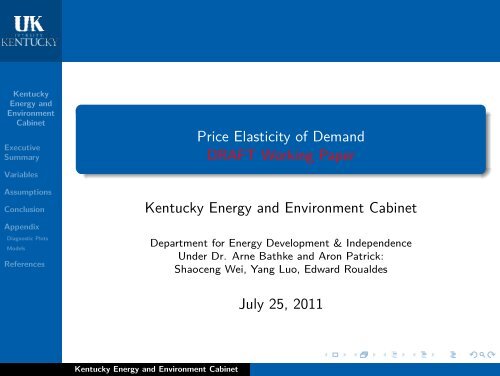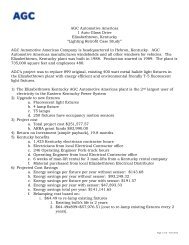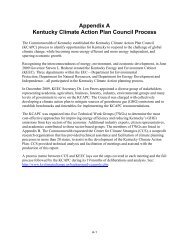Price Elasticity of Electricity Demand - Department for Energy ...
Price Elasticity of Electricity Demand - Department for Energy ...
Price Elasticity of Electricity Demand - Department for Energy ...
You also want an ePaper? Increase the reach of your titles
YUMPU automatically turns print PDFs into web optimized ePapers that Google loves.
Kentucky<br />
<strong>Energy</strong> and<br />
Environment<br />
Cabinet<br />
Executive<br />
Summary<br />
Variables<br />
Assumptions<br />
Conclusion<br />
Appendix<br />
Diagnostic Plots<br />
Models<br />
References<br />
<strong>Price</strong> <strong>Elasticity</strong> <strong>of</strong> <strong>Demand</strong><br />
DRAFT Working Paper<br />
Kentucky <strong>Energy</strong> and Environment Cabinet<br />
<strong>Department</strong> <strong>for</strong> <strong>Energy</strong> Development & Independence<br />
Under Dr. Arne Bathke and Aron Patrick:<br />
Shaoceng Wei, Yang Luo, Edward Roualdes<br />
July 25, 2011<br />
Kentucky <strong>Energy</strong> and Environment Cabinet
Overview<br />
Kentucky<br />
<strong>Energy</strong> and<br />
Environment<br />
Cabinet<br />
Executive<br />
Summary<br />
Variables<br />
Assumptions<br />
Conclusion<br />
Appendix<br />
Diagnostic Plots<br />
Models<br />
References<br />
1 Executive Summary<br />
2 Variables<br />
3 Assumptions<br />
4 Conclusion<br />
5 Appendix<br />
Diagnostic Plots<br />
Models<br />
References<br />
Kentucky <strong>Energy</strong> and Environment Cabinet
Purpose<br />
Kentucky<br />
<strong>Energy</strong> and<br />
Environment<br />
Cabinet<br />
Executive<br />
Summary<br />
Variables<br />
Assumptions<br />
Conclusion<br />
Appendix<br />
Diagnostic Plots<br />
Models<br />
This study modeled the responsiveness between electricity<br />
prices and consumption in three economic sectors, industrial,<br />
commercial, and residential, using state-level electric utility<br />
data from across the United States <strong>for</strong> the years 1990 to 2010.<br />
References<br />
Kentucky <strong>Energy</strong> and Environment Cabinet
Definition 1 <strong>of</strong> PED<br />
Kentucky<br />
<strong>Energy</strong> and<br />
Environment<br />
Cabinet<br />
Executive<br />
Summary<br />
Variables<br />
Assumptions<br />
Conclusion<br />
Appendix<br />
Diagnostic Plots<br />
Models<br />
References<br />
This responsiveness is <strong>for</strong>mally called the price elasticity <strong>of</strong><br />
demand, denoted E d . It measures the percentage change<br />
in quantity demanded <strong>of</strong> a good, given a one percent<br />
increase in the price <strong>of</strong> that good.<br />
E d =<br />
% change in quantity<br />
% change in price<br />
= ∆Q/Q<br />
∆P/P<br />
Since economic’s “Law <strong>of</strong> <strong>Demand</strong>” implies an inverse<br />
relation between P and Q, E d ≤ 0 (data don’t always<br />
agree)<br />
Kentucky <strong>Energy</strong> and Environment Cabinet
Definition 1 <strong>of</strong> PED<br />
Kentucky<br />
<strong>Energy</strong> and<br />
Environment<br />
Cabinet<br />
Executive<br />
Summary<br />
Variables<br />
Assumptions<br />
Conclusion<br />
Appendix<br />
Diagnostic Plots<br />
Models<br />
References<br />
This responsiveness is <strong>for</strong>mally called the price elasticity <strong>of</strong><br />
demand, denoted E d . It measures the percentage change<br />
in quantity demanded <strong>of</strong> a good, given a one percent<br />
increase in the price <strong>of</strong> that good.<br />
E d =<br />
% change in quantity<br />
% change in price<br />
= ∆Q/Q<br />
∆P/P<br />
Since economic’s “Law <strong>of</strong> <strong>Demand</strong>” implies an inverse<br />
relation between P and Q, E d ≤ 0 (data don’t always<br />
agree)<br />
Kentucky <strong>Energy</strong> and Environment Cabinet
Definition 1 <strong>of</strong> PED<br />
Kentucky<br />
<strong>Energy</strong> and<br />
Environment<br />
Cabinet<br />
Executive<br />
Summary<br />
Variables<br />
Assumptions<br />
Conclusion<br />
Appendix<br />
Diagnostic Plots<br />
Models<br />
References<br />
This responsiveness is <strong>for</strong>mally called the price elasticity <strong>of</strong><br />
demand, denoted E d . It measures the percentage change<br />
in quantity demanded <strong>of</strong> a good, given a one percent<br />
increase in the price <strong>of</strong> that good.<br />
E d =<br />
% change in quantity<br />
% change in price<br />
= ∆Q/Q<br />
∆P/P<br />
Since economic’s “Law <strong>of</strong> <strong>Demand</strong>” implies an inverse<br />
relation between P and Q, E d ≤ 0 (data don’t always<br />
agree)<br />
Kentucky <strong>Energy</strong> and Environment Cabinet
Results<br />
Kentucky<br />
<strong>Energy</strong> and<br />
Environment<br />
Cabinet<br />
Executive<br />
Summary<br />
Variables<br />
Assumptions<br />
Conclusion<br />
Appendix<br />
Diagnostic Plots<br />
Models<br />
References<br />
The residential sector, on average, decreases their<br />
electricity consumption by 0.7% <strong>for</strong> every 1% increase in<br />
price, ceteris paribus.<br />
The commercial sector, on average, decreases their<br />
electricity consumption by 0.3% <strong>for</strong> every 1% increase in<br />
price, ceteris paribus.<br />
The industrial sector, on average, decreases their<br />
electricity consumption by 1.2% <strong>for</strong> every 1% increase in<br />
price, ceteris paribus.<br />
All results rely on model assumptions that do not appear<br />
to be justifiable.<br />
Kentucky <strong>Energy</strong> and Environment Cabinet
Results<br />
Kentucky<br />
<strong>Energy</strong> and<br />
Environment<br />
Cabinet<br />
Executive<br />
Summary<br />
Variables<br />
Assumptions<br />
Conclusion<br />
Appendix<br />
Diagnostic Plots<br />
Models<br />
References<br />
The residential sector, on average, decreases their<br />
electricity consumption by 0.7% <strong>for</strong> every 1% increase in<br />
price, ceteris paribus.<br />
The commercial sector, on average, decreases their<br />
electricity consumption by 0.3% <strong>for</strong> every 1% increase in<br />
price, ceteris paribus.<br />
The industrial sector, on average, decreases their<br />
electricity consumption by 1.2% <strong>for</strong> every 1% increase in<br />
price, ceteris paribus.<br />
All results rely on model assumptions that do not appear<br />
to be justifiable.<br />
Kentucky <strong>Energy</strong> and Environment Cabinet
Results<br />
Kentucky<br />
<strong>Energy</strong> and<br />
Environment<br />
Cabinet<br />
Executive<br />
Summary<br />
Variables<br />
Assumptions<br />
Conclusion<br />
Appendix<br />
Diagnostic Plots<br />
Models<br />
References<br />
The residential sector, on average, decreases their<br />
electricity consumption by 0.7% <strong>for</strong> every 1% increase in<br />
price, ceteris paribus.<br />
The commercial sector, on average, decreases their<br />
electricity consumption by 0.3% <strong>for</strong> every 1% increase in<br />
price, ceteris paribus.<br />
The industrial sector, on average, decreases their<br />
electricity consumption by 1.2% <strong>for</strong> every 1% increase in<br />
price, ceteris paribus.<br />
All results rely on model assumptions that do not appear<br />
to be justifiable.<br />
Kentucky <strong>Energy</strong> and Environment Cabinet
Results<br />
Kentucky<br />
<strong>Energy</strong> and<br />
Environment<br />
Cabinet<br />
Executive<br />
Summary<br />
Variables<br />
Assumptions<br />
Conclusion<br />
Appendix<br />
Diagnostic Plots<br />
Models<br />
References<br />
The residential sector, on average, decreases their<br />
electricity consumption by 0.7% <strong>for</strong> every 1% increase in<br />
price, ceteris paribus.<br />
The commercial sector, on average, decreases their<br />
electricity consumption by 0.3% <strong>for</strong> every 1% increase in<br />
price, ceteris paribus.<br />
The industrial sector, on average, decreases their<br />
electricity consumption by 1.2% <strong>for</strong> every 1% increase in<br />
price, ceteris paribus.<br />
All results rely on model assumptions that do not appear<br />
to be justifiable.<br />
Kentucky <strong>Energy</strong> and Environment Cabinet
Variables<br />
Kentucky<br />
<strong>Energy</strong> and<br />
Environment<br />
Cabinet<br />
Executive<br />
Summary<br />
Variables<br />
Assumptions<br />
Conclusion<br />
Appendix<br />
Diagnostic Plots<br />
Models<br />
References<br />
Primary<br />
esrcp/rateres<br />
esccp/ratecom<br />
esicp/rateind<br />
Secondary<br />
area<br />
pcpi<br />
h/cdd<br />
pop<br />
sp500<br />
unemployment<br />
Residential Consumption (gWh / ¢/kWh)<br />
Commercial Consumption (gWh / ¢/kWh)<br />
Industrial Consumption (gWh / ¢/kWh)<br />
Land Area (Square Miles)<br />
Per Capita Personal Income by State<br />
Heating / Cooling Degree Days<br />
Population by State<br />
S&P 500 Stock <strong>Price</strong><br />
Unemployment Rate per State<br />
Kentucky <strong>Energy</strong> and Environment Cabinet
Variable Summary<br />
Kentucky<br />
<strong>Energy</strong> and<br />
Environment<br />
Cabinet<br />
Executive<br />
Summary<br />
Variables<br />
Assumptions<br />
Conclusion<br />
Appendix<br />
Diagnostic Plots<br />
Models<br />
References<br />
Annual data were used. Monthly data was also considered.<br />
Data over years 1990 to 2010 <strong>for</strong> the contiguous US states<br />
were used.<br />
All dollars converted to real prices.<br />
All variables trans<strong>for</strong>med with natural logarithm, denoted<br />
ln.<br />
Data come from a combination <strong>of</strong> sources, listed here .<br />
Kentucky <strong>Energy</strong> and Environment Cabinet
Variable Summary<br />
Kentucky<br />
<strong>Energy</strong> and<br />
Environment<br />
Cabinet<br />
Executive<br />
Summary<br />
Variables<br />
Assumptions<br />
Conclusion<br />
Appendix<br />
Diagnostic Plots<br />
Models<br />
References<br />
Annual data were used. Monthly data was also considered.<br />
Data over years 1990 to 2010 <strong>for</strong> the contiguous US states<br />
were used.<br />
All dollars converted to real prices.<br />
All variables trans<strong>for</strong>med with natural logarithm, denoted<br />
ln.<br />
Data come from a combination <strong>of</strong> sources, listed here .<br />
Kentucky <strong>Energy</strong> and Environment Cabinet
Variable Summary<br />
Kentucky<br />
<strong>Energy</strong> and<br />
Environment<br />
Cabinet<br />
Executive<br />
Summary<br />
Variables<br />
Assumptions<br />
Conclusion<br />
Appendix<br />
Diagnostic Plots<br />
Models<br />
References<br />
Annual data were used. Monthly data was also considered.<br />
Data over years 1990 to 2010 <strong>for</strong> the contiguous US states<br />
were used.<br />
All dollars converted to real prices.<br />
All variables trans<strong>for</strong>med with natural logarithm, denoted<br />
ln.<br />
Data come from a combination <strong>of</strong> sources, listed here .<br />
Kentucky <strong>Energy</strong> and Environment Cabinet
Variable Summary<br />
Kentucky<br />
<strong>Energy</strong> and<br />
Environment<br />
Cabinet<br />
Executive<br />
Summary<br />
Variables<br />
Assumptions<br />
Conclusion<br />
Appendix<br />
Diagnostic Plots<br />
Models<br />
References<br />
Annual data were used. Monthly data was also considered.<br />
Data over years 1990 to 2010 <strong>for</strong> the contiguous US states<br />
were used.<br />
All dollars converted to real prices.<br />
All variables trans<strong>for</strong>med with natural logarithm, denoted<br />
ln.<br />
Data come from a combination <strong>of</strong> sources, listed here .<br />
Kentucky <strong>Energy</strong> and Environment Cabinet
Variable Summary<br />
Kentucky<br />
<strong>Energy</strong> and<br />
Environment<br />
Cabinet<br />
Executive<br />
Summary<br />
Variables<br />
Assumptions<br />
Conclusion<br />
Appendix<br />
Diagnostic Plots<br />
Models<br />
References<br />
Annual data were used. Monthly data was also considered.<br />
Data over years 1990 to 2010 <strong>for</strong> the contiguous US states<br />
were used.<br />
All dollars converted to real prices.<br />
All variables trans<strong>for</strong>med with natural logarithm, denoted<br />
ln.<br />
Data come from a combination <strong>of</strong> sources, listed here .<br />
Kentucky <strong>Energy</strong> and Environment Cabinet
Kentucky<br />
<strong>Energy</strong> and<br />
Environment<br />
Cabinet<br />
Executive<br />
Summary<br />
Variables<br />
Assumptions<br />
Conclusion<br />
Skip assumptions section if statistical / mathematical language<br />
will deter you.<br />
Appendix<br />
Diagnostic Plots<br />
Models<br />
References<br />
Kentucky <strong>Energy</strong> and Environment Cabinet
Simplifying Assumptions<br />
Kentucky<br />
<strong>Energy</strong> and<br />
Environment<br />
Cabinet<br />
Executive<br />
Summary<br />
Variables<br />
Assumptions<br />
Conclusion<br />
Appendix<br />
Diagnostic Plots<br />
Models<br />
References<br />
Linearity. Q = β 0 + β 1 P + Xβ + ɛ<br />
Constant Variance. Var(ɛ i ) = σ 2 , <strong>for</strong> i = 1, . . . , N<br />
Normality. ɛ i ∼ iid N(0, σ 2 ), <strong>for</strong> i = 1, . . . , N<br />
No misspecification. All relevant predictors <strong>of</strong> Q included<br />
in the model, and linearity and additivity <strong>of</strong> predictors.<br />
<strong>Price</strong> Exogenous. P implies Q, but not vice-versa<br />
E d constant over time.<br />
Kentucky <strong>Energy</strong> and Environment Cabinet
Simplifying Assumptions<br />
Kentucky<br />
<strong>Energy</strong> and<br />
Environment<br />
Cabinet<br />
Executive<br />
Summary<br />
Variables<br />
Assumptions<br />
Conclusion<br />
Appendix<br />
Diagnostic Plots<br />
Models<br />
References<br />
Linearity. Q = β 0 + β 1 P + Xβ + ɛ<br />
Constant Variance. Var(ɛ i ) = σ 2 , <strong>for</strong> i = 1, . . . , N<br />
Normality. ɛ i ∼ iid N(0, σ 2 ), <strong>for</strong> i = 1, . . . , N<br />
No misspecification. All relevant predictors <strong>of</strong> Q included<br />
in the model, and linearity and additivity <strong>of</strong> predictors.<br />
<strong>Price</strong> Exogenous. P implies Q, but not vice-versa<br />
E d constant over time.<br />
Kentucky <strong>Energy</strong> and Environment Cabinet
Simplifying Assumptions<br />
Kentucky<br />
<strong>Energy</strong> and<br />
Environment<br />
Cabinet<br />
Executive<br />
Summary<br />
Variables<br />
Assumptions<br />
Conclusion<br />
Appendix<br />
Diagnostic Plots<br />
Models<br />
References<br />
Linearity. Q = β 0 + β 1 P + Xβ + ɛ<br />
Constant Variance. Var(ɛ i ) = σ 2 , <strong>for</strong> i = 1, . . . , N<br />
Normality. ɛ i ∼ iid N(0, σ 2 ), <strong>for</strong> i = 1, . . . , N<br />
No misspecification. All relevant predictors <strong>of</strong> Q included<br />
in the model, and linearity and additivity <strong>of</strong> predictors.<br />
<strong>Price</strong> Exogenous. P implies Q, but not vice-versa<br />
E d constant over time.<br />
Kentucky <strong>Energy</strong> and Environment Cabinet
Simplifying Assumptions<br />
Kentucky<br />
<strong>Energy</strong> and<br />
Environment<br />
Cabinet<br />
Executive<br />
Summary<br />
Variables<br />
Assumptions<br />
Conclusion<br />
Appendix<br />
Diagnostic Plots<br />
Models<br />
References<br />
Linearity. Q = β 0 + β 1 P + Xβ + ɛ<br />
Constant Variance. Var(ɛ i ) = σ 2 , <strong>for</strong> i = 1, . . . , N<br />
Normality. ɛ i ∼ iid N(0, σ 2 ), <strong>for</strong> i = 1, . . . , N<br />
No misspecification. All relevant predictors <strong>of</strong> Q included<br />
in the model, and linearity and additivity <strong>of</strong> predictors.<br />
<strong>Price</strong> Exogenous. P implies Q, but not vice-versa<br />
E d constant over time.<br />
Kentucky <strong>Energy</strong> and Environment Cabinet
Simplifying Assumptions<br />
Kentucky<br />
<strong>Energy</strong> and<br />
Environment<br />
Cabinet<br />
Executive<br />
Summary<br />
Variables<br />
Assumptions<br />
Conclusion<br />
Appendix<br />
Diagnostic Plots<br />
Models<br />
References<br />
Linearity. Q = β 0 + β 1 P + Xβ + ɛ<br />
Constant Variance. Var(ɛ i ) = σ 2 , <strong>for</strong> i = 1, . . . , N<br />
Normality. ɛ i ∼ iid N(0, σ 2 ), <strong>for</strong> i = 1, . . . , N<br />
No misspecification. All relevant predictors <strong>of</strong> Q included<br />
in the model, and linearity and additivity <strong>of</strong> predictors.<br />
<strong>Price</strong> Exogenous. P implies Q, but not vice-versa<br />
E d constant over time.<br />
Kentucky <strong>Energy</strong> and Environment Cabinet
Simplifying Assumptions<br />
Kentucky<br />
<strong>Energy</strong> and<br />
Environment<br />
Cabinet<br />
Executive<br />
Summary<br />
Variables<br />
Assumptions<br />
Conclusion<br />
Appendix<br />
Diagnostic Plots<br />
Models<br />
References<br />
Linearity. Q = β 0 + β 1 P + Xβ + ɛ<br />
Constant Variance. Var(ɛ i ) = σ 2 , <strong>for</strong> i = 1, . . . , N<br />
Normality. ɛ i ∼ iid N(0, σ 2 ), <strong>for</strong> i = 1, . . . , N<br />
No misspecification. All relevant predictors <strong>of</strong> Q included<br />
in the model, and linearity and additivity <strong>of</strong> predictors.<br />
<strong>Price</strong> Exogenous. P implies Q, but not vice-versa<br />
E d constant over time.<br />
Kentucky <strong>Energy</strong> and Environment Cabinet
Definition 2 PED<br />
Kentucky<br />
<strong>Energy</strong> and<br />
Environment<br />
Cabinet<br />
Executive<br />
Summary<br />
Variables<br />
Assumptions<br />
Conclusion<br />
Appendix<br />
Diagnostic Plots<br />
Models<br />
References<br />
Recall: “Law <strong>of</strong> <strong>Demand</strong>” implies E d ≤ 0<br />
E d = ∂ log(Q)<br />
∂ log(P)<br />
By definition, E d is estimated with the coefficient term <strong>of</strong><br />
log(P), where log(Q) is regressed on log(P).<br />
Kentucky <strong>Energy</strong> and Environment Cabinet
Definition 2 PED<br />
Kentucky<br />
<strong>Energy</strong> and<br />
Environment<br />
Cabinet<br />
Executive<br />
Summary<br />
Variables<br />
Assumptions<br />
Conclusion<br />
Appendix<br />
Diagnostic Plots<br />
Models<br />
References<br />
Recall: “Law <strong>of</strong> <strong>Demand</strong>” implies E d ≤ 0<br />
E d = ∂ log(Q)<br />
∂ log(P)<br />
By definition, E d is estimated with the coefficient term <strong>of</strong><br />
log(P), where log(Q) is regressed on log(P).<br />
Kentucky <strong>Energy</strong> and Environment Cabinet
Definition 2 PED<br />
Kentucky<br />
<strong>Energy</strong> and<br />
Environment<br />
Cabinet<br />
Executive<br />
Summary<br />
Variables<br />
Assumptions<br />
Conclusion<br />
Appendix<br />
Diagnostic Plots<br />
Models<br />
References<br />
Recall: “Law <strong>of</strong> <strong>Demand</strong>” implies E d ≤ 0<br />
E d = ∂ log(Q)<br />
∂ log(P)<br />
By definition, E d is estimated with the coefficient term <strong>of</strong><br />
log(P), where log(Q) is regressed on log(P).<br />
Kentucky <strong>Energy</strong> and Environment Cabinet
Model Selection<br />
Kentucky<br />
<strong>Energy</strong> and<br />
Environment<br />
Cabinet<br />
Executive<br />
Summary<br />
Variables<br />
Assumptions<br />
Conclusion<br />
Appendix<br />
Diagnostic Plots<br />
Models<br />
References<br />
Best subset procedure, with BIC metric, was used to<br />
select final models.<br />
All possible combinations <strong>of</strong> the predictor variables were<br />
evaluated. A mix <strong>of</strong> low BIC, economic theory, and<br />
diagnostic plots were used in picking the models.<br />
Kentucky <strong>Energy</strong> and Environment Cabinet
Model Selection<br />
Kentucky<br />
<strong>Energy</strong> and<br />
Environment<br />
Cabinet<br />
Executive<br />
Summary<br />
Variables<br />
Assumptions<br />
Conclusion<br />
Appendix<br />
Diagnostic Plots<br />
Models<br />
References<br />
Best subset procedure, with BIC metric, was used to<br />
select final models.<br />
All possible combinations <strong>of</strong> the predictor variables were<br />
evaluated. A mix <strong>of</strong> low BIC, economic theory, and<br />
diagnostic plots were used in picking the models.<br />
Kentucky <strong>Energy</strong> and Environment Cabinet
Estimates / Comparison<br />
Kentucky<br />
<strong>Energy</strong> and<br />
Environment<br />
Cabinet<br />
Executive<br />
Summary<br />
Variables<br />
Assumptions<br />
Conclusion<br />
Appendix<br />
Diagnostic Plots<br />
Models<br />
References<br />
DEDI’s Estimates<br />
Ê d,r = −0.73 ∗<br />
Ê d,c = −0.35 ∗<br />
Ê d,i = −1.23 ∗<br />
* indicates p − value < 0.01.<br />
Gatton’s Estimates<br />
−0.56 ∗<br />
−0.51 ∗<br />
−0.83 ∗<br />
Kentucky <strong>Energy</strong> and Environment Cabinet
Diagnostics<br />
Kentucky<br />
<strong>Energy</strong> and<br />
Environment<br />
Cabinet<br />
Most assumptions violated: diagnostic plots.<br />
Executive<br />
Summary<br />
Variables<br />
Assumptions<br />
Conclusion<br />
Appendix<br />
Diagnostic Plots<br />
Models<br />
References<br />
There exist some outliers, but only significant to the<br />
industrial sector. Residential and commercial sectors<br />
stable with respect to the inclusion/exclusion <strong>of</strong> outliers.<br />
Serial correlation in all sectors may imply missing predictor<br />
variable(s).<br />
Still need to check E d constant over time.<br />
Kentucky <strong>Energy</strong> and Environment Cabinet
Diagnostics<br />
Kentucky<br />
<strong>Energy</strong> and<br />
Environment<br />
Cabinet<br />
Most assumptions violated: diagnostic plots.<br />
Executive<br />
Summary<br />
Variables<br />
Assumptions<br />
Conclusion<br />
Appendix<br />
Diagnostic Plots<br />
Models<br />
References<br />
There exist some outliers, but only significant to the<br />
industrial sector. Residential and commercial sectors<br />
stable with respect to the inclusion/exclusion <strong>of</strong> outliers.<br />
Serial correlation in all sectors may imply missing predictor<br />
variable(s).<br />
Still need to check E d constant over time.<br />
Kentucky <strong>Energy</strong> and Environment Cabinet
Diagnostics<br />
Kentucky<br />
<strong>Energy</strong> and<br />
Environment<br />
Cabinet<br />
Most assumptions violated: diagnostic plots.<br />
Executive<br />
Summary<br />
Variables<br />
Assumptions<br />
Conclusion<br />
Appendix<br />
Diagnostic Plots<br />
Models<br />
References<br />
There exist some outliers, but only significant to the<br />
industrial sector. Residential and commercial sectors<br />
stable with respect to the inclusion/exclusion <strong>of</strong> outliers.<br />
Serial correlation in all sectors may imply missing predictor<br />
variable(s).<br />
Still need to check E d constant over time.<br />
Kentucky <strong>Energy</strong> and Environment Cabinet
Diagnostics<br />
Kentucky<br />
<strong>Energy</strong> and<br />
Environment<br />
Cabinet<br />
Most assumptions violated: diagnostic plots.<br />
Executive<br />
Summary<br />
Variables<br />
Assumptions<br />
Conclusion<br />
Appendix<br />
Diagnostic Plots<br />
Models<br />
References<br />
There exist some outliers, but only significant to the<br />
industrial sector. Residential and commercial sectors<br />
stable with respect to the inclusion/exclusion <strong>of</strong> outliers.<br />
Serial correlation in all sectors may imply missing predictor<br />
variable(s).<br />
Still need to check E d constant over time.<br />
Kentucky <strong>Energy</strong> and Environment Cabinet
Take Away<br />
Kentucky<br />
<strong>Energy</strong> and<br />
Environment<br />
Cabinet<br />
Executive<br />
Summary<br />
Variables<br />
Assumptions<br />
Conclusion<br />
Appendix<br />
Diagnostic Plots<br />
Models<br />
References<br />
Linear model seems <strong>for</strong>ced on the data, however estimates<br />
appear to match theory: decent first step.<br />
Differences between two studies suggest all estimates only<br />
approximate.<br />
Much further research necessary.<br />
Kentucky <strong>Energy</strong> and Environment Cabinet
Take Away<br />
Kentucky<br />
<strong>Energy</strong> and<br />
Environment<br />
Cabinet<br />
Executive<br />
Summary<br />
Variables<br />
Assumptions<br />
Conclusion<br />
Appendix<br />
Diagnostic Plots<br />
Models<br />
References<br />
Linear model seems <strong>for</strong>ced on the data, however estimates<br />
appear to match theory: decent first step.<br />
Differences between two studies suggest all estimates only<br />
approximate.<br />
Much further research necessary.<br />
Kentucky <strong>Energy</strong> and Environment Cabinet
Take Away<br />
Kentucky<br />
<strong>Energy</strong> and<br />
Environment<br />
Cabinet<br />
Executive<br />
Summary<br />
Variables<br />
Assumptions<br />
Conclusion<br />
Appendix<br />
Diagnostic Plots<br />
Models<br />
References<br />
Linear model seems <strong>for</strong>ced on the data, however estimates<br />
appear to match theory: decent first step.<br />
Differences between two studies suggest all estimates only<br />
approximate.<br />
Much further research necessary.<br />
Kentucky <strong>Energy</strong> and Environment Cabinet
Kentucky<br />
<strong>Energy</strong> and<br />
Environment<br />
Cabinet<br />
Executive<br />
Summary<br />
Variables<br />
Assumptions<br />
Conclusion<br />
Thank you<br />
Appendix<br />
Diagnostic Plots<br />
Models<br />
References<br />
Kentucky <strong>Energy</strong> and Environment Cabinet
Residential<br />
Kentucky<br />
<strong>Energy</strong> and<br />
Environment<br />
Cabinet<br />
Residuals vs Fitted<br />
Normal Q−Q<br />
Executive<br />
Summary<br />
Variables<br />
Assumptions<br />
Conclusion<br />
Appendix<br />
Diagnostic Plots<br />
Models<br />
Residuals<br />
−0.5 0.0 0.5<br />
●<br />
●●●●● ●● ●<br />
●<br />
● ●<br />
●● ●<br />
●●<br />
●<br />
●●<br />
● ●●●● ●<br />
●● ●●<br />
● ● ●<br />
●<br />
● ●<br />
● ● ●<br />
●<br />
●●●●●<br />
●● ● ●● ●●●●<br />
●<br />
● ● ●<br />
● ● ●<br />
● ● ●●● ● ●● ●●●●<br />
●<br />
●<br />
● ●<br />
●<br />
●<br />
●<br />
●<br />
●●●●●● ●<br />
● ● ●●●●<br />
●●● ●●●● ● ●<br />
●●●●● ●●●●<br />
●● ●● ●●●●●<br />
●●●● ● ●<br />
●●●<br />
●●<br />
●● ●● ●●● ●●● ●<br />
● ●●● ●●<br />
● ● ●●<br />
●●●● ●● ● ●●●● ●● ● ● ●●●<br />
●●<br />
● ●● ●●● ●● ●●●● ●<br />
● ● ●● ●● ●●●● ●●<br />
●<br />
●●●<br />
● ●●●<br />
● ● ●<br />
● ●<br />
● ●● ●● ● ● ●● ●● ●● ● ●●● ●●<br />
● ●●●● ● ● ●<br />
● ● ● ●● ●● ● ●●●●<br />
● ● ●● ● ●● ● ● ●●●● ●<br />
●● ● ●●●●●●●<br />
●● ● ●●● ● ● ●● ●●●<br />
● ●●● ● ●●●<br />
60 61<br />
● ●●● ●●●●●●● ●<br />
36<br />
●<br />
● ●● ●● ●●●● ● ●<br />
● ● ●<br />
● ●● ●●●●● ● ●●<br />
●● ●●●● ●<br />
●<br />
Standardized residuals<br />
−4 −2 0 2 4<br />
6160<br />
●<br />
● ●<br />
●●●<br />
●● ●● ●● ●● ●<br />
●●●●● ●●● ●●●<br />
●●●●●<br />
●<br />
●●●●●<br />
●●●●<br />
●●● ●●<br />
●●●●<br />
●●●<br />
●●●●<br />
●●●<br />
●<br />
●<br />
●●●<br />
●<br />
● ● ●●●●<br />
● ●<br />
●<br />
●● ●●●<br />
●●● ●● ●<br />
● ●●●<br />
● ●●●<br />
●●●●●<br />
●<br />
●●<br />
●●<br />
●● ●●<br />
● ● ● ●●●<br />
●36<br />
References<br />
8 9 10 11<br />
−3 −2 −1 0 1 2 3<br />
Fitted values<br />
Theoretical Quantiles<br />
Stable estimates with or without outliers.<br />
Kentucky <strong>Energy</strong> and Environment Cabinet
Commercial<br />
Kentucky<br />
<strong>Energy</strong> and<br />
Environment<br />
Cabinet<br />
Executive<br />
Summary<br />
Variables<br />
Assumptions<br />
Conclusion<br />
Appendix<br />
Diagnostic Plots<br />
Models<br />
Residuals<br />
−1.0 −0.5 0.0 0.5 1.0<br />
Residuals vs Fitted<br />
● ●● ● ●●● ●●● ●<br />
●<br />
●● ●● ●<br />
●● ●●<br />
●●●●●●● ● ●<br />
●<br />
● ● ●<br />
●<br />
●●●<br />
●●●● ●●● ●●● ● ●●●<br />
●●● ●● ●●●●<br />
● ●●● ●●●● ●●● ●● ●●●● ●●●<br />
● ●<br />
●● ● ● ●●● ●●●● ● ●●●●●<br />
● ●●<br />
●<br />
●●●● ●●●●<br />
●●● ● ● ● ●●●●<br />
●<br />
● ●●●●●●<br />
●●●●●<br />
●●● ●●● ●<br />
●●● ●<br />
● ●●●●<br />
● ●●●● ● ●<br />
●●●●●●● ● ●●●●<br />
● ●● ●<br />
●<br />
● ●●●● ●<br />
● ●●● ●● ● ●● ● ● ●●● ●●<br />
●●●● ●<br />
●●●●●<br />
●●<br />
●<br />
●●●●<br />
●●●● ● ●● ●●●●●<br />
●●● ●●<br />
●●●●<br />
●<br />
● ●<br />
●●●● ● ●●<br />
● ●●● ●●● ● ● ●<br />
●●● ●●●●● ● ●<br />
● ●● ●●●●●<br />
●<br />
●<br />
●<br />
●●● ● ●●●●●●●● ● ●<br />
●●●<br />
●<br />
●<br />
● ●<br />
●●●<br />
●● ●<br />
●<br />
●● ●<br />
●●<br />
●● ● ●●●<br />
● ●●●●●●●<br />
● ● ●●<br />
●<br />
826 ●●● 824 825<br />
Standardized residuals<br />
−4 −2 0 2 4<br />
● ●●● ●●<br />
●<br />
825 824 ●826<br />
●● ●<br />
Normal Q−Q<br />
●●●<br />
● ●● ● ●● ●<br />
● ●●●●<br />
●●●●●<br />
●●●●●●<br />
●●●<br />
●●● ●●●●<br />
●●●●●●●<br />
●<br />
● ●●<br />
●●●●●●●<br />
●●●●<br />
●●<br />
●<br />
● ● ●<br />
●<br />
●<br />
● ●<br />
● ●●●●●●<br />
●●●●<br />
●●●<br />
● ●● ●<br />
● ● ●<br />
References<br />
8 9 10 11<br />
−3 −2 −1 0 1 2 3<br />
Fitted values<br />
Theoretical Quantiles<br />
Stable estimates with or without outliers.<br />
Kentucky <strong>Energy</strong> and Environment Cabinet
Industrial<br />
Kentucky<br />
<strong>Energy</strong> and<br />
Environment<br />
Cabinet<br />
Residuals vs Fitted<br />
Normal Q−Q<br />
Executive<br />
Summary<br />
Variables<br />
Assumptions<br />
Conclusion<br />
Appendix<br />
Diagnostic Plots<br />
Models<br />
Residuals<br />
−1.0 0.0 0.5 1.0<br />
● ● ●● ●●<br />
●●● ●<br />
●● ●<br />
●<br />
●<br />
●<br />
●<br />
●<br />
●●●● ●● ●● ● ● ●<br />
●<br />
●<br />
● ● ●●● ● ●<br />
●● ● ● ●●<br />
●●<br />
●●<br />
●<br />
●● ●<br />
● ●● ●●<br />
●<br />
●● ● ●● ●● ●<br />
●<br />
●●●<br />
● ●● ●● ● ●● ●● ● ●●●●● ●<br />
● ●● ●●●●● ●●●●● ● ●<br />
●● ●●● ●●●●<br />
●<br />
●●●<br />
●<br />
●<br />
●●●●<br />
●●<br />
●●●● ●● ●● ●● ●● ●●<br />
●●● ●●<br />
●<br />
●● ●● ●●● ●● ● ● ●●● ●●● ●<br />
● ●<br />
●<br />
● ●<br />
●●● ● ●●● ● ●<br />
●<br />
●<br />
●<br />
●<br />
●● ●● ● ●<br />
●●<br />
●● ●<br />
●<br />
● ●● ●● ●● ●<br />
●● ●<br />
●● ●<br />
● ● ●<br />
●● ●● ● ●●●●<br />
●<br />
●●<br />
●● ● ● ●<br />
● ●<br />
●<br />
● ● ● ●<br />
● ●<br />
● ● ●<br />
●●●<br />
● ●<br />
●● ●<br />
●●●●<br />
● ●<br />
● ●<br />
●●●<br />
●●● ●<br />
● ●● ● ● ● ●<br />
●● ● ● ●<br />
●● ● ●● ●● ● ●●● ● ●<br />
● ●● ● ●●●● ●●● ●● ●<br />
●<br />
●● ●●<br />
●<br />
●●● ●<br />
●● ● ● ●<br />
●● ● ●●●● ●<br />
●<br />
●●● ● ● ●●<br />
●<br />
●●●● ●<br />
●●<br />
●<br />
●●● ●<br />
●<br />
●<br />
●<br />
●<br />
●<br />
● ●● ●● ●●●<br />
●● ●● ● ● ● ● ● ● ●● ● ● ●●● ●<br />
●<br />
● ●<br />
●● ●●<br />
● ●<br />
● ●● ●<br />
●<br />
●<br />
●<br />
●<br />
●<br />
●●<br />
●<br />
●● ●●●<br />
●<br />
●<br />
●●<br />
● ●<br />
160 161 671●<br />
Standardized residuals<br />
−3 −2 −1 0 1 2 3<br />
●<br />
●●●●<br />
●●<br />
●●● ●●●<br />
●●●<br />
●●●<br />
● ● ●●<br />
●●<br />
●<br />
● ●<br />
●<br />
●●●<br />
●●●●<br />
●●●●<br />
●●●●●●<br />
●●●●<br />
●<br />
●●●●●<br />
●●● ●●● ●●● ●●●●●●<br />
●<br />
●●● ●●<br />
●●●● ●●<br />
●●●<br />
●<br />
●<br />
●●●● ●<br />
●<br />
●<br />
●<br />
●●●●<br />
●●●● ●● ●<br />
●● ●● ●●<br />
● ●<br />
●●● ●● ● ●<br />
● ●●<br />
●●● ●●●<br />
●<br />
●<br />
●<br />
● ●<br />
161 671 160<br />
●<br />
References<br />
8 9 10 11<br />
−3 −2 −1 0 1 2 3<br />
Fitted values<br />
Theoretical Quantiles<br />
Estimate goes to −0.7 with outliers removed.<br />
Kentucky <strong>Energy</strong> and Environment Cabinet
Residential Model<br />
Kentucky<br />
<strong>Energy</strong> and<br />
Environment<br />
Cabinet<br />
Executive<br />
Summary<br />
Variables<br />
Assumptions<br />
Conclusion<br />
Appendix<br />
Diagnostic Plots<br />
Models<br />
References<br />
Estimate Std. Error t value Pr(>|t|)<br />
(Intercept) -1.3554 0.2986 -4.54 0.0001<br />
lesrcd -0.7298 0.0255 -28.58 0.0001<br />
lwacdd 0.0725 0.0139 5.20 0.0001<br />
lwahdd -0.2183 0.0207 -10.52 0.0001<br />
lpop 0.9332 0.0071 130.81 0.0001<br />
Kentucky <strong>Energy</strong> and Environment Cabinet
Commercial Model<br />
Kentucky<br />
<strong>Energy</strong> and<br />
Environment<br />
Cabinet<br />
Executive<br />
Summary<br />
Variables<br />
Assumptions<br />
Conclusion<br />
Appendix<br />
Diagnostic Plots<br />
Models<br />
References<br />
Estimate Std. Error t value Pr(>|t|)<br />
(Intercept) -4.1050 0.2804 -14.64 0.0001<br />
lesccd -0.3464 0.0319 -10.87 0.0001<br />
lsp500 0.1845 0.0222 8.32 0.0001<br />
lwahdd -0.1487 0.0163 -9.14 0.0001<br />
lpop 0.9538 0.0087 109.38 0.0001<br />
Kentucky <strong>Energy</strong> and Environment Cabinet
Industrial Model<br />
Kentucky<br />
<strong>Energy</strong> and<br />
Environment<br />
Cabinet<br />
Executive<br />
Summary<br />
Variables<br />
Assumptions<br />
Conclusion<br />
Appendix<br />
Diagnostic Plots<br />
Models<br />
References<br />
Estimate Std. Error t value Pr(>|t|)<br />
(Intercept) 0.0066 0.3919 0.02 0.9865<br />
lesicd -1.2339 0.0534 -23.08 0.0001<br />
lsp500 -0.2918 0.0373 -7.83 0.0001<br />
larea 0.0325 0.0148 2.19 0.0288<br />
lwacdd 0.0738 0.0184 4.00 0.0001<br />
lpop 0.8628 0.0147 58.73 0.0001<br />
Kentucky <strong>Energy</strong> and Environment Cabinet
Data Sources<br />
Kentucky<br />
<strong>Energy</strong> and<br />
Environment<br />
Cabinet<br />
Executive<br />
Summary<br />
Variables<br />
Assumptions<br />
Conclusion<br />
Appendix<br />
Diagnostic Plots<br />
Models<br />
References<br />
Variable Source<br />
<strong>Price</strong><br />
Consumption<br />
(EIA, 2009)(EIA, 2011)(EIA-SEDS, 2009)<br />
area<br />
pop<br />
(Census, 2011)<br />
pcpi<br />
unemployment<br />
(BLS, 2011)<br />
hdd<br />
cdd<br />
(NOAA, 2011)<br />
sp500 (Shiller, 2001)<br />
Kentucky <strong>Energy</strong> and Environment Cabinet
References I<br />
Kentucky<br />
<strong>Energy</strong> and<br />
Environment<br />
Cabinet<br />
Executive<br />
Summary<br />
Variables<br />
Assumptions<br />
Conclusion<br />
Appendix<br />
Diagnostic Plots<br />
Models<br />
References<br />
BLS. (2011). Bureau <strong>of</strong> Labor Statistics. Retrieved July 2011,<br />
from bls.gov/data<br />
Census. (2011). U.S. Census. Retrieved July 2011, from<br />
factfinder2.census.gov/faces/nav/jsf/pages/<br />
index.xhtml<br />
EIA. (2009). Form EIA-861. Available from www.eia.gov/<br />
cneaf/electricity/page/eia861.html<br />
EIA. (2011, June 10). Form EIA-826. Available from<br />
www.eai.gov/cneaf/electricity/page/<br />
eia826.html<br />
EIA-SEDS. (2009). U.S. <strong>Energy</strong> In<strong>for</strong>mation Administration -<br />
State <strong>Energy</strong> Data System. Retrieved July 2011, from<br />
www.eia.gov/state/seds/#<br />
Kentucky <strong>Energy</strong> and Environment Cabinet
References II<br />
Kentucky<br />
<strong>Energy</strong> and<br />
Environment<br />
Cabinet<br />
Executive<br />
Summary<br />
Variables<br />
Assumptions<br />
Conclusion<br />
Appendix<br />
Diagnostic Plots<br />
Models<br />
NOAA. (2011). National Oceanic and Atmospheric<br />
Administration. Retrieved July 2011, from<br />
www.ncdc.noaa.gov/oa/ncdc.html<br />
Shiller, R. J. (2001). Irrational exuberance. Princeton, NJ.:<br />
Princeton University Press.<br />
References<br />
Kentucky <strong>Energy</strong> and Environment Cabinet
















